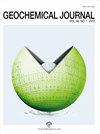Application of B and Li isotope systematics for detecting chemical disturbance in groundwater associated with large shallow inland earthquakes in Kumamoto, Japan
M. Tanimizu, N. Sugimoto, T. Hosono, C. Kuribayashi, T. Morimoto, A. Ito, R. Umam, Y. Nishio, K. Nagaishi, T. Ishikawa
求助PDF
{"title":"Application of B and Li isotope systematics for detecting chemical disturbance in groundwater associated with large shallow inland earthquakes in Kumamoto, Japan","authors":"M. Tanimizu, N. Sugimoto, T. Hosono, C. Kuribayashi, T. Morimoto, A. Ito, R. Umam, Y. Nishio, K. Nagaishi, T. Ishikawa","doi":"10.2343/geochemj.2.0633","DOIUrl":null,"url":null,"abstract":"Copyright © 2021 by The Geochemical Society of Japan. caused by such contamination is sometimes enhanced by anthropogenic activities such as excessive pumping of groundwater (Smith et al., 2018; Jasechko et al., 2020). In addition, natural disasters such as large earthquakes can also trigger these problems. By analyzing the major ion concentrations, trace element concentrations, and stable isotope ratios of water molecules, several studies have described changes in the natural composition of groundwater in response to seismotectonic activities (Tsunogai and Wakita, 1995; Manga and Rowland, 2009; Barberio et al., 2017; Skelton et al., 2019). However, these changes have been rarely described using stable isotope ratios of dissolved trace elements (Poitrasson et al., 1999; Schuessler et al., 2016). The detailed mechanisms and processes of hydrochemical changes in the regional groundwater system of Kumamoto region of southern Japan in response to the Mw 7.0 Kumamoto crustal earthquake of 2016 were previously investigated using a high-resolution well monitoring network. The results suggested that a co-seismic groundwater drawdown surrounding the epicenter was Application of B and Li isotope systematics for detecting chemical disturbance in groundwater associated with large shallow inland earthquakes in Kumamoto, Japan","PeriodicalId":12682,"journal":{"name":"Geochemical Journal","volume":"60 1","pages":""},"PeriodicalIF":1.0000,"publicationDate":"2021-01-01","publicationTypes":"Journal Article","fieldsOfStudy":null,"isOpenAccess":false,"openAccessPdf":"","citationCount":"3","resultStr":null,"platform":"Semanticscholar","paperid":null,"PeriodicalName":"Geochemical Journal","FirstCategoryId":"89","ListUrlMain":"https://doi.org/10.2343/geochemj.2.0633","RegionNum":4,"RegionCategory":"地球科学","ArticlePicture":[],"TitleCN":null,"AbstractTextCN":null,"PMCID":null,"EPubDate":"","PubModel":"","JCR":"Q3","JCRName":"GEOCHEMISTRY & GEOPHYSICS","Score":null,"Total":0}
引用次数: 3
引用
批量引用
B、Li同位素系统在熊本内陆大浅层地震地下水化学扰动探测中的应用
日本地球化学学会版权所有©2021。这种污染造成的污染有时会因人为活动而加剧,例如过度抽取地下水(Smith等人,2018;Jasechko et al., 2020)。此外,大地震等自然灾害也会引发这些问题。通过分析水分子的主要离子浓度、微量元素浓度和稳定同位素比率,一些研究描述了地下水自然组成对地震构造活动的变化(Tsunogai和Wakita, 1995;Manga and Rowland, 2009;Barberio et al., 2017;Skelton et al., 2019)。然而,很少使用溶解微量元素的稳定同位素比率来描述这些变化(Poitrasson等人,1999;Schuessler et al., 2016)。利用高分辨率井监测网络,研究了2016年日本南部熊本地区7.0级地震后地下水系统水化学变化的详细机制和过程。应用B、Li同位素系统检测熊本地区内陆大浅层地震地下水化学扰动
本文章由计算机程序翻译,如有差异,请以英文原文为准。


